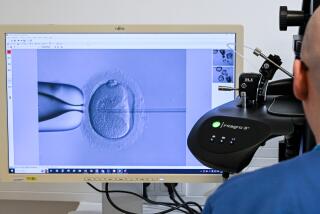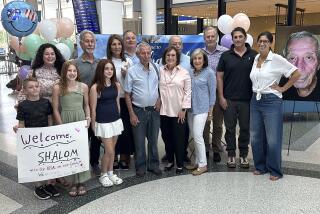The Unreal World: Tracking down sperm-donor dads
- Share via
“Donor Unknown”
Met Film and Redbird
Tribeca Film Festival, April 23 premiere
The premise
In this documentary, JoEllen Marsh is a 20-year-old woman who has never met her father. For most of her life, he was known only as sperm donor 150 from the California Cryobank, a large sperm bank based in Los Angeles. Marsh turns to a website called the Donor Sibling Registry and eventually discovers she has more than a dozen half-siblings with the same anonymous father. Some of them meet in person, and they discover that they share many traits: a high forehead with arched eyebrows, a love of animals, an analytical and outgoing personality, and a similar sense of humor. After reading a newspaper article about Marsh’s search, donor 150 decides that his children have the right to meet him. He reveals himself to be Jeffrey Harrison, a self-described beach bum who takes odd jobs and lives in an RV on Venice Beach. He says he paid his rent for eight years in the 1980s and 1990s by making three or four sperm donations per week at $50 a donation. Marsh and several of her half-siblings meet Harrison in person.
The medical questions
Are there restrictions on the number of donations a man can make or the number of children that can be fathered by from a single donor? What is the rationale for allowing fathers to remain anonymous? Do children have a right to know genetic information about their donor fathers? Are personality traits and one’s sense of humor strongly influenced by DNA? What are the emotional costs and benefits of meeting a biological father who has been absent through one’s entire childhood?
The reality
There are no regulations that limit the number of times a man can donate sperm, nor the number of times his sperm is used, according to Dr. Peter Schlegel, chairman of urology and professor of reproductive medicine at the Weill Medical College of Cornell University in New York. Making as many as four donations per week is “an acceptable practice from a medical standpoint,” he says, but adds that based on population studies, the American Society for Reproductive Medicine now recommends that the number of children from an individual donor in a geographical area not exceed 10. “This limits the risk of a brother and sister meeting and marrying” without realizing they are related, Schlegel says.
Sperm banks should provide clients with the reproductive history of each donor, says Dr. Andrew McCullough, director of andrology at the Albany Medical College in New York. “Why would a healthy, clear-thinking woman knowingly put her child in a situation where he/she had so many half-siblings from the same father?” he says. Luckily, he adds, most sperm banks today try to prevent this from happening by limiting the number of times a man can donate, though in the 1980s sperm banks were not as strict.
There have been surprise meetings of siblings that sparked fears of accidental incest: In South Australia, one man’s sperm was reportedly used to produce 29 children, most of whom came to live in the city of Adelaide (population 1.2 million). With more than 1 million children of donors alive today, a documented case of accidental incest would seem to be inevitable, Schlegel says.
Donor anonymity is given to encourage men to make donations, says Arthur Caplan, director of the Center for Bioethics at the University of Pennsylvania in Philadelphia. Sperm banks fear potential donors will get cold feet if they think they may be held financially or legally responsible for the children they help produce, he says. But donors need to understand that “anonymity cannot be enforced,” Caplan adds. “When children, for emotional or health reasons, want to find their ‘biological’ parents, records are unsealed and they do.” Kids trump parents, Caplan concludes, and their need to know is more important: “Courts will go this way, as they do in adoption.”
Donor sperm is frequently screened for common genetic mutations that can cause serious diseases, such as sickle cell anemia, Tay-Sachs disease and cystic fibrosis, Schlegel says. However, not all genetic disorders can be screened for, and there have been case reports in the medical literature of clusters of patients with rare blood disorders and kidney abnormalities that were traced back to a handful of prodigious donors.
A person’s temperament and personality style — whether she is shy and reserved or outgoing and gregarious — is rooted in genetics, says Dr. Harold Koplewicz, a child and adolescent psychiatrist and president of the Child Mind Institute in New York. But assessing the degree to which children share the personality traits of the donor fathers is a much more subjective exercise than determining whether they both have high foreheads or arched eyebrows. Besides, how a child is raised plays an important role in how personality develops, Koplewicz says, “so the final answer for genetics and personality is a definite ‘maybe.’”
The literature on meeting an absent father comes from adopted children who find their biological parents later in life, Koplewicz says. It may be rewarding to find out where you and your characteristics, deficits and gifts “come from,” Koplewicz adds. But having to deal with the fact that your biological father was just a donor of a bodily fluid who was trying to pay the rent can be very painful — his attachment to his donation is nonexistent, and yet the children have endless fantasies about “their father.” This mismatch of expectations is a formula for disappointment, and the fantasy is much better than reality, Koplewicz says.
JoEllen Marsh herself sees it more positively. “Meeting Jeffrey was very meaningful for me,” she said in an interview. “He may not be what we expected, but he has a wonderful heart, and I can respect the way he’s chosen to live his life.”
Marsh believes that sperm donation is wonderful if the people involved remember that they are creating children who will someday be curious about where they came from. “I have no regrets about the way I was conceived,” she said, “but I think that’s mostly because my parents were open and honest about it from the very beginning.”
Siegel is an associate professor of medicine at New York University Langone Medical Center. His new book is “The Inner Pulse: Unlocking the Secret Code of Sickness and Health.”






